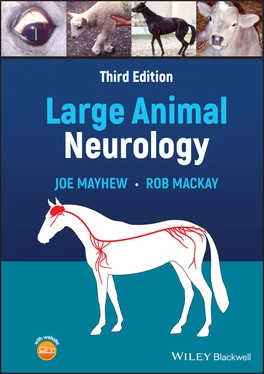Such two‐engine gaits that can be seen with prominent C 6–T 2lesions involving gray and white matter can also be seen, probably less often, with forebrain, brainstem, and cervical, thoracic and lumbar spinal cord lesions. Thus, this syndrome is not pathognomonic for C 6–T 2lesions.
In addition to observing for signs of abnormal gait and posture indicative of weakness, the three most useful postural reaction tests for determining the presence of weakness in the limbs of a horse suffering from spinal cord disease are the tail pull, the tail and halter pull, and thoracic limb hopping. Pulling the tail while the patient remains standing initiates an extensor, quadriceps contraction, mimicking the performance of a patellar reflex. As an example, this reflex is poor when there is a final motor neuron lesion at the level of L 4–5, and therefore such a patient will demonstrate weakness in poorly resisting a tail pull while standing still as well as voluntary weakness with poor resistance offered while the patient is moving. In contrast, an example of a wobbler horse with a central motor pathway cervical lesion will have good resting muscle tone and will be difficult to pull to the side by the tail in a singular progressive movement while standing still, but will easily be pulled to the side while walking. The first example demonstrates depressed extensor reflexes in the pelvic limbs, while the wobbler demonstrates intact or even hyperactive extensor reflexes in the pelvic limbs in the face of voluntary, central motor pathway weakness. Ease at causing the patient to sway sideways with lateral pull on the tail likely reflects the loss of hindlimb strength and/or proprioceptive abilities. However, the tail pull test is very useful in detecting extensor weakness in the pelvic limbs, but it is often performed far too vigorously; it is not a contest between examiner and patient! For this assessment, it is best to apply constant lateral tension to the tail and determine what voluntary pull the patient exerts against that tension while it is weight‐bearing on the nearest limb during the stance phase.
Interpretation of results of tail pull test
Abnormal standing test: Suggestive of ipsilateral final motor neuron lesion, L3 to S2 gray matter or nerves.
Normal standing and abnormal walking tests: Lateralizing only, ipsilateral brainstem to S2 central motor and/or general proprioceptive pathways.
The tail and halter pull test is performed by pulling on a lead rope and on the tail while circling the horse around the examiner who is testing a postural reaction and also evaluating voluntary strength. In addition, it can exaggerate a patient’s tendency to pivot on a hindlimb demonstrating either flexor weakness or hypometria and to exacerbate maneuvering limbs in an ataxic fashion. Again, ease in pulling the patient to the side during circling occurs usuall because of weakness resulting from central motor pathway involvement, from a lesion that involves final motor neurons in either ventral horn gray matter level with the limb or the peripheral nerves, from a lesion involving muscle, or as a result of a painful process. With final motor neuron, muscle, and painful conditions, extensor weakness is often profound, and it is easy to pull such a patient to the side while it is standing still and while circling. In contrast, a weak animal with a lesion of the central motor pathways can usually reflexly fix the limb in extension when pulled to one side by the halter and tail, whereas while circling, the patient does not have the voluntary motor strength necessary to forcibly resist against the examiner’s pull.
Hopping a patient laterally on one thoracic limb while the pelvic limbs are free to move may reveal that a horse is weak by a tendency for it to tremble on a thoracic limb when the opposite thoracic limb is held up to initiate the hopping test. Such a patient will also have difficulty in hopping to the side and may stumble when pushed away with the examiner’s shoulder; this test being best performed on soft ground.
Flexor paresis is often evident when an animal drags its toes, has worn hooves, and has a low arc and long swing phase to the stride. When an animal bears weight on a limb demonstrating extensor weakness, the limb often trembles and the animal may even collapse on that limb because of the lack of support. While circling, walking on a slope, and walking with the head elevated, such an animal frequently will stumble on a limb having extensor weakness and will knuckle over at the fetlock. This compares nicely with the patient having central motor pathway weakness, and ataxia, that walks stiff legged with the thoracic limbs but usually without knuckling over at the fetlock.
With severe weakness in all four limbs, but with no ataxia, neuromuscular disease must be considered. Profound weakness in only one limb is suggestive of a peripheral nerve or muscle lesion in that limb. Weakness occurs with central motor pathway lesions in the brainstem and spinal cord, and it is present in the limb(s) on the same side and caudal to the lesion. A patient with a peracute peripheral vestibular syndrome may appear weak in the limbs on the same side as the lesion because of the decreased extensor tone and tendency to fall in that direction and the increased extensor tone in the contralateral limbs. It can be difficult to be sure that a patient with prominent ataxia but no pathologic evidence of motor pathway problems such as with cerebellar abiotrophy or perennial ryegrass toxicity is not clinically weak. Such patients can be readily made to move laterally with constant tail pulling but will pull forcibly against such lateral pull when standing and when the lateral force is applied firmly only when the limb is in the propulsive phase of stride.
Markedly asymmetric weakness and/or pain can result in the sidewinder syndrome with the patient “crab walking” or moving “on two tracks” 14(see Chapter 25).
Ataxia is a term that, by its Greek derivative, means a lack of order or an inconsistency. In this context, ataxia is a proprioceptive dysfunction causing abnormal rate, range and force of movement, and placement of the limbs and other body parts, including head, neck, trunk, and even at times the eyes. Ataxia thus essentially reflects changes in function of the subconscious proprioceptive mechanisms. What the examiner must see to interpret as ataxia is irregular and mostly unpredictable movement and placement of the limbs, head, neck, or trunk.
The patient is observed while standing still, walking, trotting, turning tightly, and backing up, and while the patient moves in a serpentine path with the head held elevated and while moving on a slope. The best way of accomplishing the latter maneuvers is to walk backward in a zigzag manner while holding the lead rope high to extend the patient’s head and neck. The aim is to alter the intended direction of the patient’s limbs while they are in protraction by turning the lead abruptly such that there must be a change in direction of each foot to be placed in the site the examiner intends for it to be placed. Some horses will not obligingly turn in tight or even large circles for examination. With practice, circling can be best accompanied by walking the horse forward and then starting to turn in one direction slowly making the turn slightly tighter as the examiner moves from in front of the horse to level with the shoulder, then to level with the middle of the trunk, while coaxing the horse by flicking the rump with the free end of the lead rope. This way the patient turns around the examiner, not the examiner around the horse. Essentially, these maneuvers comprise the postural reaction tests for large animals. These tests alter input to the central motor pathways through changes in many modalities, including the visual horizon, vestibular stimulation, and neck and limb proprioception, that is synthesized with cerebellar input into refined motor system signals. Subtle neurologic abnormalities, which may be compensated for under conditions of normal gait, are exaggerated during these maneuvers. Ataxic movements can be seen as irregular and mostly unpredictable foot flight and placement. To detect subtle asymmetry in limb protraction and the length of stride, it can be useful to walk parallel to, or behind the animal, matching step‐for‐stride. An ataxic gait is sometimes most pronounced when an animal is moving freely in a paddock especially when attempting to stop abruptly from a trot or canter when the limbs may be wildly adducted or abducted.
Читать дальше












